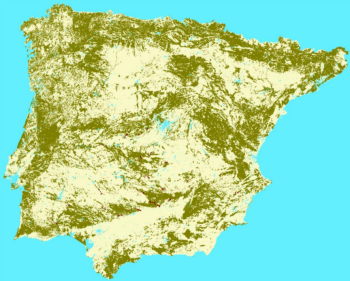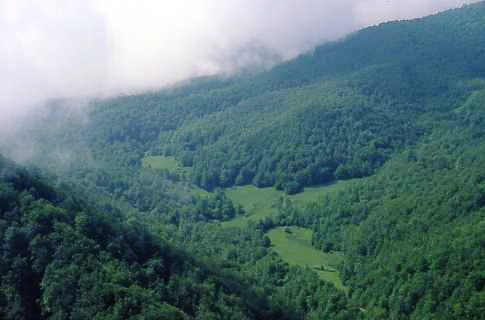 population ecology and conservation
population ecology and conservation
research ( species | space | populations | vulnerability | traffic )
 Understanding the factors driving the dynamics of a population requires digging into the internal and external processes associated with the demographic processes of reproduction, survival and movement (at least over ecological -very short- time scales). Those processes interact, have positive and negative feedbacks and covariate with environmental factors, while interacting with other dynamic populations (eg. diseases or predators). Mechanistic approaches to population dynamics are very relevant for conservation since they allow us to identify the relevant drivers and to link the relevant patterns in space and time with processes at the individual and population levels. In the end we attain some predictive capacity, very useful for answering management and conservation questions. Process-based population ecology is challenging since it requires a lot of information on the functional relationships and the relevant demographic parameters and the use and development of new methods (for example individual based simulation models).
Understanding the factors driving the dynamics of a population requires digging into the internal and external processes associated with the demographic processes of reproduction, survival and movement (at least over ecological -very short- time scales). Those processes interact, have positive and negative feedbacks and covariate with environmental factors, while interacting with other dynamic populations (eg. diseases or predators). Mechanistic approaches to population dynamics are very relevant for conservation since they allow us to identify the relevant drivers and to link the relevant patterns in space and time with processes at the individual and population levels. In the end we attain some predictive capacity, very useful for answering management and conservation questions. Process-based population ecology is challenging since it requires a lot of information on the functional relationships and the relevant demographic parameters and the use and development of new methods (for example individual based simulation models).
Wiegand, T., E. Revilla & F. Knauer (2004) Reducing uncertainty in spatially explicit population models. Biodiversity and Conservation 13: 53-78
Grimm, V., E. Revilla, U. Berger, F. Jeltsch, W. M. Mooij, S. F. Railsback, H-H. Thulke, J. Weiner, T. Wiegand & D. L. DeAngelis. (2005) Pattern-oriented Modeling of Agent-based Complex Systems: Lessons from Ecology. Science 310: 987-991
Palomares, F., E. Revilla, J. Calzada, N. Fernández & M. Delibes (2005) Reproduction and pre-dispersal survival of Iberian lynx in a subpopulation of the Doñana National Park. Biological Conservation 122:53-59
Kramer-Schadt, S, E. Revilla, T. Wiegand & V. Grimm. (2007). Patterns for parameters in simulation models. Ecological Modelling 204: 553-556
 One of the challenges of conservation biology is dealing with the highly stochastic dynamics of small populations, including population viability analyses, the evaluation of the impact of individual extraction and reintroduction programs and other management actions. We have worked on applied projects for different administrations in charge of management and conservation, including projects with Iberian and Eurasian lynx.
One of the challenges of conservation biology is dealing with the highly stochastic dynamics of small populations, including population viability analyses, the evaluation of the impact of individual extraction and reintroduction programs and other management actions. We have worked on applied projects for different administrations in charge of management and conservation, including projects with Iberian and Eurasian lynx.
Revilla, E., A. Rodríguez, J. Román, y F. Palomares 2007. Análisis de viabilidad de la metapoblación de lince ibérico de Doñana: una estrategia de manejo adaptativo para su conservación. Pp. 307-323 en Proyectos de investigación en parques nacionales: 2003-2006. L. Ramírez & B. Asensio (eds.). Parques Nacionales, Ministerio de Medio Ambiente, Madrid
Kramer-Schadt, S., E. Revilla & T. Wiegand. (2005) Lynx reintroductions in fragmented landscapes of Germany: projects with a future or misunderstood wildlife conservation? Biological Conservation 125:169-182 Supp. Matherial
 More general questions are related with spatial processes, including the effects of habitat heterogeneity, loss and fragmentation on populations or the evaluation of the impact of a heterogeneous dispersal matrix, thus putting the role of dispersal in par with mortality and reproduction.
More general questions are related with spatial processes, including the effects of habitat heterogeneity, loss and fragmentation on populations or the evaluation of the impact of a heterogeneous dispersal matrix, thus putting the role of dispersal in par with mortality and reproduction.
Wiegand T., E. Revilla, & K. A. Moloney. (2005) Effects of habitat loss and fragmentation on population dynamics. Conservation Biology 19:108-121
Revilla E, T Wiegand. (2008) Individual movement behavior, matrix heterogeneity and the dynamics of spatially structured populations. Proceedings of the National Academy of Sciences USA 105:19120-19125
 To me, one to the most suggesting ideas is the integration of information across systems, scales and studies in search for generalizations on the main factors and processes driving the dynamics of specific species. This is relevant when dealing with complex situations in which it is difficult to separate at once more than two main processes in a single population. Understanding the dynamics of European rabbits is a real challenge since it is simultaneously modulated by food availability, predation by generalist and specialist predators, and two or three contrasting diseases (see the PhD of Zulima Tablado).
To me, one to the most suggesting ideas is the integration of information across systems, scales and studies in search for generalizations on the main factors and processes driving the dynamics of specific species. This is relevant when dealing with complex situations in which it is difficult to separate at once more than two main processes in a single population. Understanding the dynamics of European rabbits is a real challenge since it is simultaneously modulated by food availability, predation by generalist and specialist predators, and two or three contrasting diseases (see the PhD of Zulima Tablado).
Tablado Z, E Revilla, F Palomares (2012). Dying like rabbits: general determinants of spatio-temporal variability in survival. Journal of Animal Ecology 81:150-161. doi:10.1111/j.1365-2656.2011.01884.x
Tablado Z, E Revilla, F Palomares. (2009) Breeding like rabbits: Global patterns of variability and determinants of European wild rabbit reproduction. Ecography 32: 310-320 suppl. Matherial
Tablado Z, E Revilla. (2012) Contrasting effects of climate change on rabbit populations through reproduction. PLoS One 7(11): e48988 doi:10.1371/journal.pone.0048988
wild rabbit photo by Antonio Sabater
